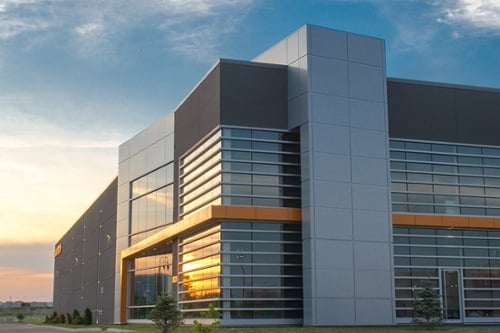Warehouses and distribution centers experience some of their busiest times during the year, often driven by seasonal demand, extreme weather events, and holiday surges. These peak periods place immense pressure on operations, requiring strategic planning and timely adjustments to maintain both efficiency and safety.
For facility managers, understanding the dynamics of warehouse peak season is essential to ensuring smooth workflows, managing labor needs, preventing costly disruptions, and protecting infrastructure from excessive wear and tear. In this article, we’ll break down what peak season means in the supply chain, when it typically occurs, the challenges it presents, and key strategies to help your warehouse operate effectively during the year’s most demanding periods.
Jump to Section:
What is Peak Season in the Supply Chain?
Peak season in the supply chain refers to periods of the year when demand for goods significantly increases, leading to higher volumes of inventory movement, order processing, and shipping. This surge is often driven by factors like holidays, extreme weather events, and seasonal buying trends. Warehouses, distribution centers, and logistics companies must prepare for these fluctuations to ensure efficient operations and minimize delays.
What Is the Meaning of Peak Season in Warehousing?
The meaning of peak season varies by industry, but in warehousing and logistics, it represents the time when businesses experience heightened demand, requiring additional resources, labor, and strategic planning to manage inventory and shipments effectively. Peak seasons can be predictable, such as the holiday rush, or unpredictable, like sudden demand due to extreme weather conditions or global supply chain disruptions.
Main Peak Season Periods for Warehouses and Distribution Centers
Understanding when your warehouse is most likely to experience peak demand can help you plan accordingly. Here are some of the most critical times to watch out for during the warehouse peak seasons:
1. Pre-Holiday Logistics (Late October to December)
One of the busiest times of the year for most warehouses and distribution centers is the period leading up to the holidays. Retailers, e-commerce platforms, and manufacturers ramp up their production to meet consumer demand for gift items, electronics, clothing, and seasonal products. This is typically the time when inventory levels are the highest, orders are coming in faster than ever, and workers are under pressure to ship products before the holidays.
During the peak holiday season—covering Thanksgiving, Black Friday, Cyber Monday, and beyond—consumer demand surges. In 2023, a record 197 million people shopped over Thanksgiving weekend. For instance, Amazon captured 29% of global order volume in the two weeks leading up to Christmas.
To handle this rush, facilities often increase their staffing levels and work overtime. However, the increased demand can also strain warehouse infrastructure, especially when it comes to managing storage and product movement safely.
2. Post-Holiday Returns (January)
The weeks following the holiday season are marked by high return volumes, a surge in demand for exchanges, and increased pressure to handle inventory changes quickly. Warehouse operations during this time can be just as intense as during the pre-holiday period, but the focus shifts to reverse logistics.
Managing returns requires careful planning, as workers need to sort and inspect returned items, restock shelves, and prepare for the upcoming inventory cycles.
3. Extreme Weather Events – Heat Waves & Storms
Extreme weather conditions, such as heat waves, hurricanes, and tornadoes, are unpredictable but can significantly disrupt warehouse operations during peak seasons. These events can halt shipments, delay deliveries, and create sudden spikes in demand for essential goods.
During heat waves, warehouses often see increased demand for bottled water, cooling units, fans, and hydration products. In contrast, snowstorms, hurricanes, and tornadoes drive a surge in non-perishable foods, batteries, flashlights, generators, and emergency supplies as consumers and businesses prepare for potential power outages and supply chain disruptions. Warehouses must stay agile, monitoring weather patterns and adjusting inventory levels to meet these shifting demands efficiently.
4. Additional High-Demand Periods Warehouses Must Manage
While the holiday season is the most well-known peak for warehouse activity, it’s far from the only one. Several other key periods throughout the year also put pressure on supply chains:
- Back-to-School Season: Late summer brings a surge in demand for school supplies, electronics, and clothing. Total back-to-school sales in 2024 are projected to reach $81.16 billion, marking a 3.2% increase from the previous year.
- E-commerce Events: Online shopping events like Amazon Prime Day, Singles’ Day, and Cyber Week drive major order spikes. In 2024, Amazon Prime Day sales reached $14.2 billion in the United States, marking an 11.7% increase from the previous year.
- New Product Launches: Tech companies like Apple and Samsung rely heavily on warehousing during product launches to handle high volumes and ensure timely delivery.
- Seasonal Industries: From fashion’s seasonal turnover to agriculture’s harvest periods, many sectors rely on warehouses to manage fluctuating inventory levels.
- Promotions in Health & Beauty: Brands like Sephora and L’Oréal experience warehousing surges during product drops and gift set promotions.
- Home Improvement Season: Spring and summer spark increased activity, with Home Depot reporting a 23.4% sales jump in 2020 during this period.
How Long is Peak Season for Warehouses?
Peak season for warehouses can vary depending on the industry, location, and demand cycles. Generally, the most intense peak seasons last between two to four months, with the holiday season (October to January) being the most significant. However, other factors, such as back-to-school shopping, summer product demand, and extreme weather events, can extend peak periods. Warehouses need to remain flexible and prepared year-round to handle these fluctuations efficiently.
The Impact of Peak Season Demand & Challenges Faced by Warehouses
When warehouses and distribution centers experience heightened activity, the challenges are manifold. From operational bottlenecks to safety concerns, facilities need to be prepared to handle the surge during their peak season.
Increased Risk of Accidents and Damages
When staff is working at full capacity, fatigue and distractions can lead to an increased risk of accidents. Forklifts moving faster, more orders being processed, and the rush to ship out goods create a perfect storm for rack collisions, product damage, and even personal injuries.
Warehouses should implement preventive measures, such as regular equipment inspections and employee training, to minimize these risks. Damotech offers complete rack safety training, helping you and your team stay safe during challenging times.
Infrastructure Wear and Tear
As traffic intensifies, the wear and tear on warehouse infrastructure also accelerates. Overcrowded aisles, overloaded racks, and frequent forklift collisions can all result in damaged storage systems. If racks aren’t reinforced or protected, a single impact can result in severe damage that disrupts the entire operation.
Damotech’s rack protection solutions help minimize this risk by offering robust, affordable ways to safeguard your racks from impact and preserve the integrity of your infrastructure, no matter the workload.
3 Tips to Prepare Your Warehouse for Peak Season Demand
The key to handling peak season warehouse demands effectively is preparation. Here are a few tips to ensure your warehouse can operate at maximum efficiency when the pressure’s on:
1. Maintain a Flexible and Prepared Warehouse Workforce
During peak times, it’s essential to have a flexible workforce that can scale up quickly. Consider hiring temporary workers or utilizing overtime as needed. Having a well-trained staff who can adapt to the workload and safely operate machinery in high-traffic areas is vital for keeping the operation running smoothly.
Moreover, safety should always be a priority, especially when your warehouse is running at full speed. Order your free copy of our Safety poster now and hang it in your warehouse to fortify safety measures.
2. Plan for Seasonal Warehouse Demand
Use historical data and demand forecasting tools to predict which products will see increased demand at specific times of the year. This insight allows you to allocate space better, streamline order fulfillment, and prevent bottlenecks. To stay ahead, look at trends from previous years, track SKU velocity, and monitor seasonal buying patterns.
For example, during a heat wave, you may need to stock up on fans, air conditioning units, and hydration products. Meanwhile, winter seasons consistently demonstrate higher sales volumes for heating products and cold-weather accessories. By proactively preparing for these predictable seasonal fluctuations, companies can maintain optimal inventory levels, ensure timely order fulfillment, and maximize storage efficiency throughout the year.
3. Invest in Pallet Racking Maintenance and Protection
Rack damage is one of the leading causes of warehouse downtime, often resulting from forklift collisions, misaligned pallets, or overloading. When racking is compromised, it not only disrupts operations but also creates serious safety hazards, increases the risk of product loss, and leads to costly emergency repairs. During peak seasons, when warehouse activity is at its highest, the risk of damage rises significantly, making proactive maintenance and protection essential.
To prevent costly downtime and a loss of productivity, regularly inspect your racking systems and invest in rack protection. Damotech’s durable, cost-effective solutions, including industrial-strength rack repair kits and reinforced rack protection, help keep your warehouse running smoothly. Our quick-to-install protection products safeguard rack columns and uprights from forklift impacts, ensuring your infrastructure remains intact during high-stress periods.
By proactively maintaining and reinforcing your racking system with Damotech’s repair and protection solutions, you can extend the life of your warehouse infrastructure, minimize disruptions, and improve workplace safety.
Conclusion: Ensuring Your Success During Warehouse Peak Season
Busy seasons bring real challenges for warehouses and distribution centers—but with the right preparation, you can stay ahead. By investing in rack protection, streamlining your operations, and planning around demand trends, you’ll minimize risks and keep things running smoothly, even at peak volume.
At Damotech, we’re here to help you stay safe and productive year-round. From expert safety training to industry-leading rack protection and repair solutions, we provide everything you need to reinforce your infrastructure and maintain operational excellence.
Be ready for anything—partner with Damotech and take on peak season with confidence. Get in touch with us today!
Sources:













